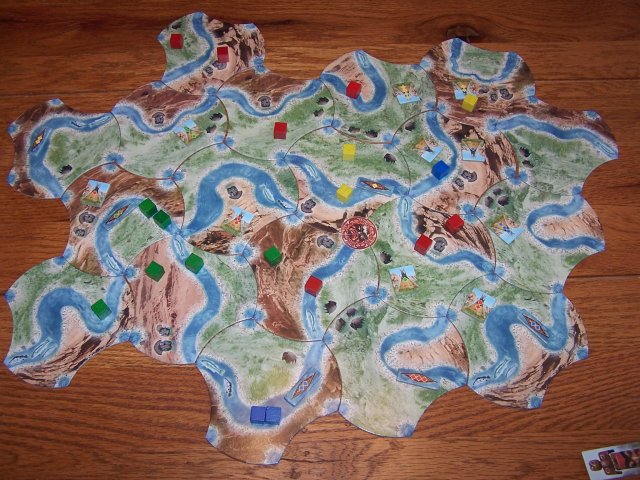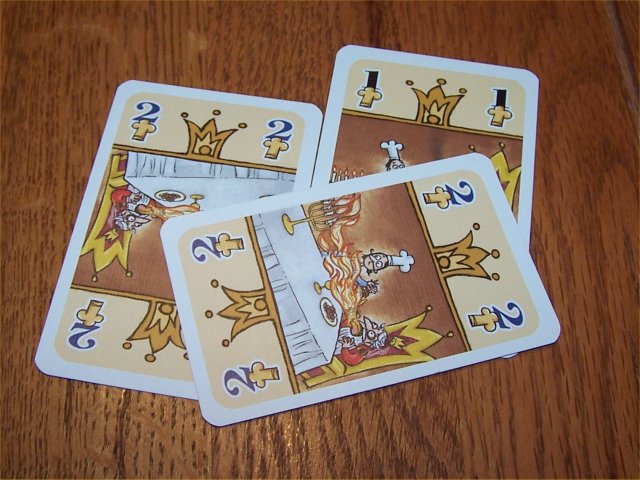
August 6, 2006Bison and Figaro - First Impressionsby Susan Rozmiarek I’m going to interrupt my Gulf Games reports to comment on a few of the upcoming Mayfair releases. We hosted a game day yesterday and I was able to give them a whirl. After everyone left, I surfed on over to BGG to check out the ratings for these games and was especially surprised to see some lukewarm ratings for Bison which I thought was quite good. Perhaps more playings will reveal some flaws? At any rate, here are my initial impressions:Bison: Thunder on the PrairieBison is a tile-laying, area majority game that reminds a bit of Carcassonne with a dash of Entdecker and Tikal. What it also has is an incredibly tight resource management system that had me agonizing over my decisions. I have grown tired with area majority control games and they were never my favorite type in the first place. However, this one impressed me quite a bit. Briefly the game plays as follows:The playing area will be formed during the game by playing oddly shaped tiles that depict different landscape types and associated wild game- turkeys, fish and bison. As the regions grow, players will fight to control the most valuable ones, those with the most animals. Like Carcassonne, when a player places a tile, he can place his hunters on one of the landscape types depicted. Then, with various actions, he can move hunters around (Tikal) and establish teepees on land or canoes on water for majority control in the regions of a single landscape type that form during the game. The majority scoring works a lot like it does in Entdecker – a single, higher valued teepee or canoe beats any number of lower valued ones or hunters. The game is played in “seasons” in which players take exactly four actions, one-by-one, in turn order. At the end of a season, players collect their hunting bounty for the season. They will get the number of turkeys, fish and bison depicted in the areas that they control. Players in 2nd down to fourth place will also potentially receive animals as well. This is where the tight resource management comes into play. Every action that involves more than one hunter will involve a cost in animals. The costs of actions depend on the number of hunters involved and are the same for each action, making it simple to remember. Placing two hunters on a tile costs the same as moving two hunters which costs the same as replacing two hunters with a two-valued canoe. The price rises sharply as more hunters are used. It also costs animals to buy more canoes, hunters and teepees from the market to use on the board. A varying amount of all three types of animals is needed, so you must have a supply of each and can’t focus on a single type. I found myself constantly having to scrimp and manage my animals as I never had enough. The winner is determined after four seasons in a four-player game and is the player who is able to hunt the most animals at that time. Animals saved over from previous seasons don’t count. At the end of the game, players lose the animals that they still have and then score the territories. Whoever has the most animals wins the game. Another cool feature that I liked in the game is the fact that players can only take each action once during a season. So, if I am fighting an opponent for control of a river, I can check whether or not he’s used the “build canoe” action this season and evaluate what course of action I might take to guarantee my success. Between trying to manage my animal supply and keeping a constant eye on what actions my opponents still have available to them, I found the game to be quite challenging with lots of agonizing decisions. Bison does have some luck with randomly drawn tiles and it’s very dry with a theme doesn’t always make sense (for example, teepees and canoes cannot ever move once placed. Huh?), but I was quite impressed with the game. There is, as is usual in games of this type, a lot of potential for the dreaded “analysis paralysis” problem. But, despite the fact that I’ve played dozens of area majority games over the years, this one felt original even with some familiar mechanisms. There definitely seemed to be enough there to keep those who like “gamer’s games” happy and it lived up to my expectations of a Kramer/Kiesling collaboration. The others at the table were rather impressed with it as well. The game is also quite beautiful with art by Franz Vohwinkel. I hope to write a full review of it after I’ve played it several more times.
FigaroThe other new Mayfair game that I got to play was Figaro, which I played twice. I always approach daVinci games with trepidation because many of them don’t click with me. However, I had more hope for Figaro because it’s designed by Reiner Knizia. I wasn’t as “wowed” by it as I was with Bison, but I enjoyed it more than I thought I would after reading the rules. It’s very light and a bit chaotic, but there are some nuances to the game that were not immediately apparent. It appears to me that Mr. Knizia took the core mechanism - that of playing cards to piles until they all added up to a certain value and then had to be taken by a player - and then developed several games with it. Too Many Cooks, Poison, and now Figaro joins this group of games. It is a “take that” sort of game as you are playing cards directly on players to try and force them to collect cards when the value of their pile reaches six. In this game, collecting cards is bad. I was a little afraid that there would be too much piling on the leader, but it all seemed to work pretty well. Some of the plays are driven by trying to save one’s self from taking cards, rather than hurting a particular player.The theme is silly and one that has really been forced on, making little sense in how it relates to some of the mechanisms. I’d love to know what Mr. Knizia’s original theme for it was, because surely this can’t be it. I’m not going to bother trying to explain it other than it takes place in the King Me! world; I’ll save that for a review. It does make for some cute, whimsical art, though. I really liked the illustrations. Fortunately, theme does not matter so much to me, especially in a light and quick game such as this one. I haven’t decided if I like the odd way of scoring, but I will say that it does make the game stand out which perhaps was the intention. Road tiles of random lengths are drawn at the beginning of the game and grouped in sets, one for each round. Losers in each round take the longer segments while the winner takes none. At the end of the game, everyone places their segments together to form a road and the player with the shortest road wins. This seemed rather fiddly, but I guess it works. All-in-all, this is a nice, light filler that I’m looking forward to playing more. It may be a game that I tire of after a half dozen plays or it could be the next filler favorite of the gaming group. We’ll see.
Comments
Don't forget the rule where the winner in the third round can swap his longest road for the shortest road in the third round before people have taken the tiles. I really didn't like this rule. Mike Posted by: Mike C. -- on August 7, 2006 10:23 AMI thought the scoring in Figaro sounded strange too, but now that I think about it, I think it's pretty clever. You could use just numbered scoring cards, but then everyone would know exactly how many points everyone had. You could keep them hidden, but then players with good memories would have an advantage. By using the road segments, you have a good idea of who is winning, but you can't calculate it exactly. Posted by: Mark Haberman on August 7, 2006 10:27 AM@ Mike: Yeah, that rule does seem to come out of left field. I'm not sure what purpose it serves. @ Mark: Good point. I think we could have done a better job hiding our road segments by stacking them. It was usually pretty obvious who was winning or losing at a given time. Posted by: Susan on August 11, 2006 6:22 PMWhen I first heard about Bison, I got excited. We like tile-laying games, and the theme sounded great. Then, I learned that it's for four players. Darn! If they release an expansion for 6 players, I'll buy it. Posted by: Gerald McDaniel on September 23, 2006 10:40 AMPost a comment
This page viewed E-mail Ed Rozmiarek with questions or problems concerning this page. Copyright © 2006, Ed & Susan Rozmiarek. |

